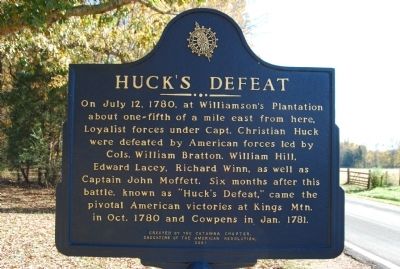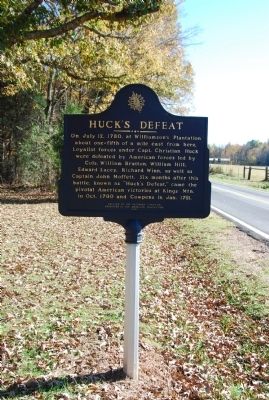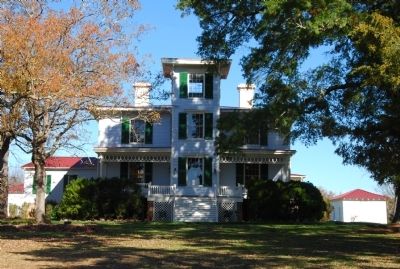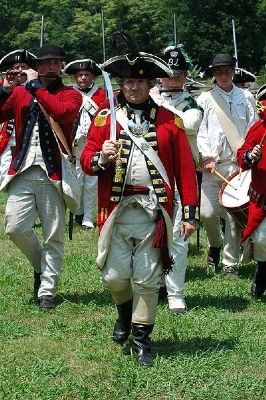Near McConnells in York County, South Carolina — The American South (South Atlantic)
Huck's Defeat
On July 12, 1780, at Williamson's Plantation about one-fifth of a mile east from here, Loyalist forces under Capt. Christian Huck were defeated by American forces led by Cols. William Bratton, William Hill, Edward Lacey, Richard Winn, as well as Captain John Moffett. Six months after this battle, known as "Huck's Defeat," came the pivotal American victories at Kings Mtn. in Oct. 1780 and Cowpens in Jan. 1781.
Erected 2001 by Catawba Chapter-Daughters of the American Revolution. (Marker Number 46-28.)
Topics and series. This historical marker is listed in these topic lists: Agriculture • Settlements & Settlers • War, US Revolutionary. In addition, it is included in the Daughters of the American Revolution series list. A significant historical month for this entry is July 1852.
Location. 34° 52.422′ N, 81° 10.878′ W. Marker is near McConnells, South Carolina, in York County. Marker is on Brattonsville Road, half a mile south of McConnells Highway (South Carolina Highway 322), on the left when traveling south. Touch for map. Marker is in this post office area: Mc Connells SC 29726, United States of America. Touch for directions.
Other nearby markers. At least 10 other markers are within 2 miles of this marker, measured as the crow flies. Bratton Home (approx. 0.6 miles away); William Bratton Plantation/Battle of Huck's Defeat (approx. 0.6 miles away); Field of Huck's Defeat (approx. 0.7 miles away); The Battle of Huck’s Defeat (approx. 0.7 miles away); Backwoods Cabin (approx. 0.7 miles away); Brick Kitchen (approx. 0.7 miles away); The Homestead (approx. 0.7 miles away); Brattonsville (approx. 0.7 miles away); A House of Untold Stories (approx. 0.7 miles away); Bethesda Presbyterian Church (approx. 1.7 miles away). Touch for a list and map of all markers in McConnells.
Also see . . .
1. South Carolina Department of Archives and History. Site contains short history of Hightower Hall and additional photos. (Submitted on November 15, 2009, by Michael Sean Nix of Spartanburg, South Carolina.)
2. Myrevolutionarywar.com. Article on Battle of Huck's Defeat (Submitted on November 15, 2009, by Michael Sean Nix of Spartanburg, South Carolina.)
3. Wikipedia entry for Huck's Defeat. Huck’s Defeat or the Battle of Williamson's Plantation was an engagement of the American Revolutionary War that occurred in present York County, South Carolina on July 12, 1780, and was one of the first battles of the southern campaign to be won by Patriot militia. (Submitted on November 15, 2009, by Michael Sean Nix of Spartanburg, South Carolina.)
Additional commentary.
1. Williamson's Plantation
Williamson's Plantation is no longer standing. Hightower Hall is the current structure on the former plantation grounds.
— Submitted November 15, 2009, by Michael Sean Nix of Spartanburg, South Carolina.
2. Hightower Hall
Hightower Hall is a two-story frame residence, built ca. 1853 for John Simpson Bratton, II. The contract between Bratton and his builder, O.P. Cranford (or Crawford), described in detail the house as it was planned and built. The contract specified that Mr. Bratton was to build the foundation and basement walls and to provide the materials for the rest of the house, which Mr. Cranford (or Crawford) was to complete. Hightower Hall, an interpretation of the Italian Villa style, is located in York County on a large farm near McConnells.
Hightower Hall has a rectangular plan, with a projecting three-story square tower on the facade (southwest elevation). The house is weatherboarded with a raised brick basement. The facade has a single eight-over-eight window in the basement of the tower, with twin brick staircases rising on either side of the tower to approach twin one-story porches on either side of the tower. These porches rest on high brick piers and feature chamfered square posts, sawn brackets, stickwork friezes, and sawn ornament in their balustrades. Siding is flushboard under these porches. The three-bay facade has the tower centered and a single eight-over-eight sash window with louvered shutters 1n the flanking bays on each floor. The tower has single entrances with transoms on each side of its first story, opening onto the porches; each other exposed face has a single eight-aver-eight window.
The main body of the house has a low hip roof, with sawn brackets under its projecting eaves. The roofing is asphalt shingle. Two brick chimneys pierce the center of the roof. The tower roof is similar to the roof of the main house, with sawn brackets under its projecting eaves.
The northeast elevation of Hightower Hall has a one-story porch with chamfered posts and sawn brackets, similar to but less elaborate than the southwest porches. Siding is flushboard underneath the porch. A one-story frame building on a brick basement, believed to be the original kitchen, is attached to this porch on the northwest side. The side elevations of Hightower Hall are two bays wide.
Interior: Hightower Hall has a central-hall, double-pile plan with the hall extended to the southwest into the tower. The walls of the first floor hall and the stair are plastered, with marble pilasters simulated in trompe l'oeil painting. The stair rises at the east end of the hall, opposite the tower. A plaster ceiling medallion is centered in the hall; this is attributed to Richard Hare. The four rooms of the first and second floors have pine floors, two-panel doors, plaster walls, and wooden mantel pieces and baseboards. The tower, which has its own stair leading to the third levels rises ten feet above the main roof of the house. The tower was reportedly designed as an observation platform so that Mr. Bratton could watch over his plantation.
Surroundings: An unidentified Englishman reportedly designed the gardens of Hightower Hall. The plantation includes four original outbuildings, two barns and two slave cabins.
Significance
Hightower Ha11, located in the vicinity of McConnells in York County, South Carolina, was built for John Simpson Bratton II, a locally prominent planter and politician, ca. 1853. The residence is a significant vernacular interpretation of the Italian Villa style. In addition, Hightower Hall is significant for the hand-painted mural in its first. floor central hall, which simulates marble pilasters.
Additional Information: John Simpson Bratton II, a member of the prominent area Bratton family, was apparently a successful planter. In 1850, three years before he constructed his new plantation home, the twenty-eight year old Bratton owned $9,000 worth of land and eight slaves. By 1860, Bratton had been in his fine new home approximately seven years and had acquired thirty-eight slaves and real estate valued at $24,000. Bratton served in the South Carolina House of Representatives for two terms, was postmaster of Brattonsville, and was a member of the Soldiers Board of Relief during the Civil War. He died in 1888.
Architecture: Hightower Hall, built ca. 1853, is a significant vernacular rendition of the Italian Villa style that was popular in the United States from 1837 to ca. 1860. The style had its origins in the vernacular farmhouses of the northern Italian peninsula, whose asymmetry and picturesqueness were appreciated by the eighteenth-century Grand Tourers. The first expression of the style in Northern Europe was John Nash's Cronkhill at Salop, England, built,in 1802. The style was introduced into the United States in 1837 at Bishop Doane's house in Burlington, New Jersey, designed by architect John Hotman. A.J. Downing popularized the style in his publications, Cottage Residences (1840) and The Architecture of Country Houses (1850).
The style was characterized by picturesque compositions, with a tall square tower rising above the main mass of the building. Deep, bracketed eaves, verandas or loggias, homogeneous wall surfaces, and low-pitched roofs further characterized the style. Hightower Hall's most prominent feature, its three-story tower, identifies its stylistic sources. The house features, also, the low-pitched roof, the deep eaves, the brackets and the verandas common to the style. Other examples of the Italian Villa style in South Carolina include the Williams House in Laurens (ca. l850) and the Wofford College Old Main (designed by E.C. Jones, built 1854).
Hightower Hall is also noteworthy for its trompe l'oeil painting, simulating marble pilasters, in its hall. A similar painting scheme is found at Alison Plantation (ca. 1854) in York County. This was a mode by which a builder of limited skill could approach the effects of the more luxurious lowcountry plantation houses. (Source: National Register nomination form.)
— Submitted January 15, 2010, by Brian Scott of Anderson, South Carolina.
3. Williamson's Plantation/Huck's Defeat
Date: July 12, 1780
Location: Brattonsville, York County
Commanders: Col. William Bratton, Capt. John McClure; Capt. Christian Huck
Casualties: American-1k, 1w; British-36k, 29c
Although the British now solidified their presence in South Carolina with outposts all along the midlands, partisan leaders managed to keep up a constant harassment. Thomas Sumter was knocking at the back door of the British stronghold at Rocky Mount and, in response, the commander there sent Capt. Christian Huck of Tarleton's Legion to deal with the Patriots. Huck ravaged the countryside on his way to Hill's Iron Works, where he destroyed this valuable source of munitions and farm implements. Col. William Hill joined with Capt. John McClure, Col. William Bratton (who had defeated a band of Tories at Mobley's Meeting House), and Capt. Edward Lacey to engage Captain Huck, who would be camped at Williamson's Plantation.
On his way to Williamson's, Huck and his officers had struck terror in the hearts of local residents. At Captain McClure's house, Huck found two young men melting pewter dishes to make bullets for the Patriot cause. Huck dumped the boys in a corn crib and told them they would be hanged the next morning. When Mrs. McClure protested, he struck her with his sword and they rode off to Colonel Bratton's house. There, Mrs. Bratton was ordered to prepare a meal for the intruders, and when Huck demanded she tell him where her husband was, she professed ignorance. One of the officers snatched a reaping hook from the wall and held it to her throat, threatening to cut off her head if she did not disclose the whereabouts of the Patriots. She steadfastly refused and another officer intervened on her behalf before her blood was shed. Capt. Edward Lacey's home was also in the area, but his worry was not of his wife or mother covering for him and thus invoking Huck's wrath, but rather of his father betraying him, as the old man was an avowed Loyalist. Lacey had to tie him to his bed to keep him from warning Huck of the Patriots' movements.
Secure in the delusion that he commanded the area, Huck had failed to post pickets at his camp, which lay between rail fences lining the road. They never heard the Patriots who snuck up on the sleeping British and opened fire at 75 paces. Huck mounted his horse to rally his troops but was shot in the neck and killed. Few others escaped death or capture. This American victory is significant because it was the first time a loose-knit band of Patriots had met and conquered an organized unit of British regulars. (Source: South Carolina's Revolutionary War Battlefields: A Tour Guide by R.L. Barbour (2002), pgs 41-42.)
— Submitted January 10, 2010, by Brian Scott of Anderson, South Carolina.
Credits. This page was last revised on December 15, 2019. It was originally submitted on November 15, 2009, by Michael Sean Nix of Spartanburg, South Carolina. This page has been viewed 1,739 times since then and 44 times this year. Photos: 1, 2, 3, 4. submitted on November 15, 2009, by Michael Sean Nix of Spartanburg, South Carolina. • Syd Whittle was the editor who published this page.



